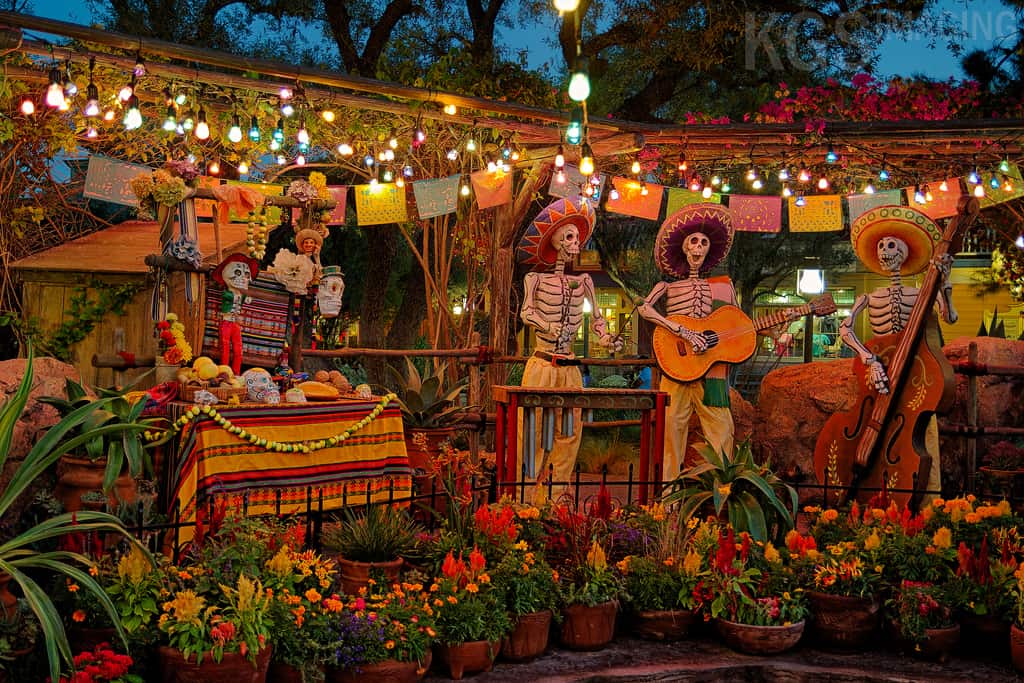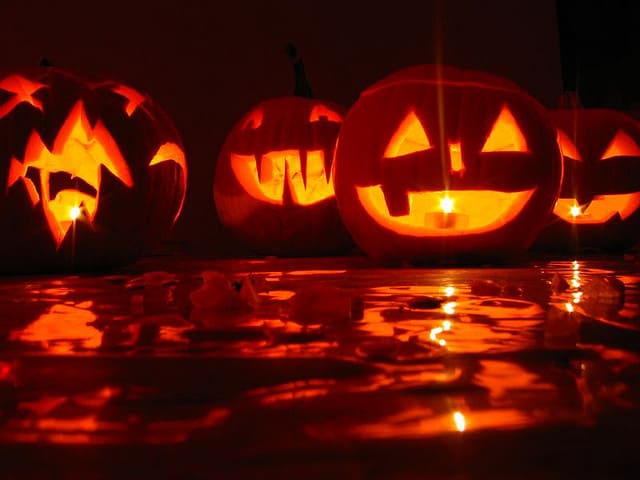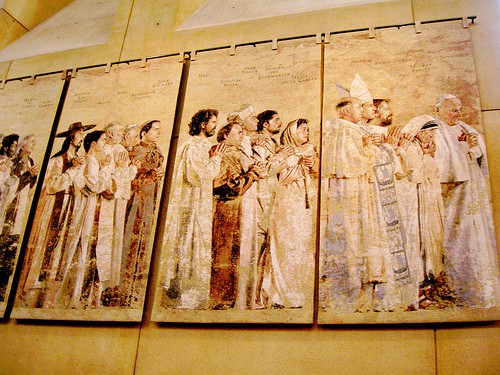On Halloween night, the veil between the world of the living and the world of the dead thins, allowing spirits from these different realms to communicate with one another. Or at least those are the words I heard on some Halloween special when I was a kid. Seriously, it was always those words: thinning veils, spiritual realms. I did not even know what they meant. I just knew they were spooky. But while I distinctly remember a strange feeling in my chest when twilight came and the jack o’lanterns were lit, it was not really about spirits. It was that I knew I would soon be putting charcoal on my face,1 walking around after dark without parents, and getting a pillowcase full of candy. (Score!)
While we were out, there were a couple of houses whose lights were always black on Halloween. It was the sign to STAY AWAY! My macabre imagination peered inside where there was probably an old man and woman (like…in their fifties), smoking like chimneys and wearing too-tight, brown, polyester turtlenecks painting apples with poisonous resin. I swear…true imaginary story. It caused me to reject any gift of fruit placed in my pillowcase (I mean honestly, who hands out fruit on Halloween? Bad people, that’s who). Mostly though, unless you count the older kids who might try to filch our candy, danger was never all that close to us. We would spend the evening laughing, exchanging information with other kids about which houses were giving what, and seeing how far our legs could carry us before it was time to go in.
As a kid, Halloween was about as good as it got. No family stuff. No tedious church services. Just costumes, candy, and a lot of laughs. Of course, there was the “scare factor” which just about heightened every sense. I loved the idea of making up weird and creepy costumes. Did unknown spirits that really walk the earth? I was somewhat ambivalent. I loved ghost stories, but by the time I was nine I knew that nothing as cool as seeing floating lights or strange skeletal beings emerging from behind the locked gates of cemeteries ever really happened. I knew the truth. The biggest evils we had to worry about were not the spirits that we could not see or the ones that inhabited decaying bodies and clawed their way out of the Earth. The biggest evils we needed to worry about were the real spirits living in normal people that could do some pretty terrible things.
As an adult, I still love Halloween. Part of me feels like it is a perfect free-form festival. Its like an American mini-Carnivale . People ingest various types of simple sugars (either of the kid or adult variety). We get to dress up in costumes, by turns creative, cute, creepy, and cool. No one really cares if you do something strange or your costume is lame. It is a last hurrah before the Autumn months get all serious and our minds turn to those other holidays that take a lot of time and effort.
In the midst of all the celebrating, though, there is an underlying awareness that Halloween really is all about spirits and realms of the undead, after all. Pulsing just beneath our costume shells is the truth of who we really are. We are not our masks. We are mortal. Death is never that far away.
* * *
As far as many North Americans are concerned, Halloween is basically a secular festival. Catholics, though, might recognize it as the day before we begin the transition into the final weeks of our year. We go from Halloween into All Saints and finally All Souls. Our focus is on those spirits who have passed through the veil into eternity. We think of those saints who have died as well as those people whose lives were maybe a little less than beatific. These thoughts are accompanied by readings at Mass which begin to turn our attention to the end of times. Thus, with the month of November comes an awareness which moves in and out of my consciousness: death. Not just death, but death, judgment, virtue, vice, purgatory, eternity and the ways that we use prayer, symbols and our imaginations to make sense of what happens when earthly life ends.
On the Day of the Dead, that Mexican festival which celebrates the lives of the deceased, I love that everywhere you look you see skeletons. While living in the Bay Area, I went to a celebration where I watched a woman dancing who had a skull painted on half her face.2 She had pinned pictures of people she was dancing for around her waist – an old man, a young girl, a teenage boy holding a gun…these were not pictures from magazines…they were photographs. These were images captured in time that somehow represented the lives of those who were important to her. She whirled around in a sea of dancers, each with their own images attached to their clothing in various ways. They turned and stepped to the heavy rhythms, their faces turning from flesh, to bone, and to flesh again. It seemed like they were all dancing not just for themselves, or for the memories of their particular friends, but for all of us – both living and dead.
From an outsider’s point of view, this festival might be confused for something Halloween-like. And maybe it is, a little. But this festival is not a single evening of fun and candy. Yes, the children get sugar skulls to eat. But there are also feasts and music and dancing….and prayer…and altars.
It is around the altars that one finds the heart of the celebration. The altars are small booths erected in honor of the deceased. The artwork and personal effects that adorn each shrine reveal a keen awareness of the life of the dead person being celebrated. Depicted on these altars, and present in the ones who keep vigil over them, we find all of life’s emotions. There is sorrow, fear, uncertainty, and even regret. There is also joy and deep love held for the spirit who has passed, and humor and gratitude expressed for the memory that remains. The skeletal images that embody the terror of our unknown end help reveal the awareness of the things that make our lives worth living. It is a festival that seems dedicated to the grotesque truths and fantastic hopes of death and life in this world and the next.
The truth is, we are just like those dancers: skeleton and flesh. We dress up our bones to make it seem like we are something other than we are, but each of us will pass from this world. There are so many ways for us to get lost along the way. Sometimes we lose sight of the immediacy of our lives – the nearness of life’s demands; the fact that we exist here and now, even as we think of the past and future. We have impressions that are always present which shape our choices about how we live.
We can feel so insulated from our awareness of physical mortality that our faith becomes a stale, pietistic, happening that does not affect our lives. Yet, circumstances may force us to confront evil and search for the good. We will need to find ways to address the very real terrors of this world, while keeping compassion, joy, and humor alive in our hearts. Here, in the midst of this celebration, I was witness to a seemingly endless earthly dance where people struggled to make sense of pain and find joy in the middle of what seemed like chaos.
* * *
And this is why I still love Halloween. We are dressing up as something other, stepping out of this world for a while, and receiving candy for our efforts. When we dress up, we are bearing the nearness of mortality, the primacy of physical pleasure, and the basic urge to walk in the twilight world. It is a celebration of humanity: goods, evils, fairies, demons all mingling with each other for one night on Earth. At the same time, Halloween is not its own holiday, but the beginning of a three-day festival – a kind of Triduum.
All Hallow’s Eve, the night before All Saints Day, ushers us into a day of meditation on those who have died, so that we who live might celebrate what we have been given. With All Saints, the people of the Church hold in memory those who lived and died for the sake of virtue: perseverance, courage, selflessness and above all love of God. Each of the people we celebrate manifested excellence (if not perfection) in one way or another. All Saints is followed by All Souls – a day of more open celebration and mourning for all of those we used to know that have since passed from this world. Heroes, villains, or just regular folk — our cultural memory is filled with accounts of the lives of those who have lived. Our family histories, likewise, might be filled with people who seem to fall into the categories of “sinner” more than saint. By telling their stories, by praying for them, we seek rest for their souls and peace for ours.
In the Communion of Saints, the eternal banquet of heaven, we are always celebrating this eternal feast. One grace of the Eucharist (that’s right, a plug for the Holy Day of Opportunity on November 1!) is that we might enter into a celebration of those souls who lived and died in the Holy Spirit, unified, bound to one another, by the love of Christ. In these celebrations,on these three days at the end of October and the beginning of November, we enter a temporal space where the souls of all, past and present, might be united in love and celebration over the mysterious miracle of Being itself. That these days are ushered in by an attentiveness to the profane is not in itself a terrible thing. Rather, it simply names the reality of what it is that we live with every day. All those little monsters running around out there, they are human…they are us.
* * *
Cover image from KGSImaging available at Flickr here
— — — — —





